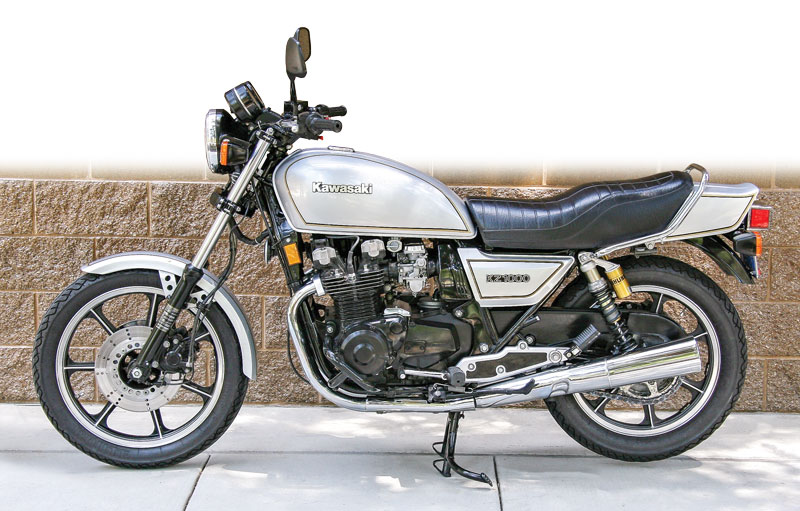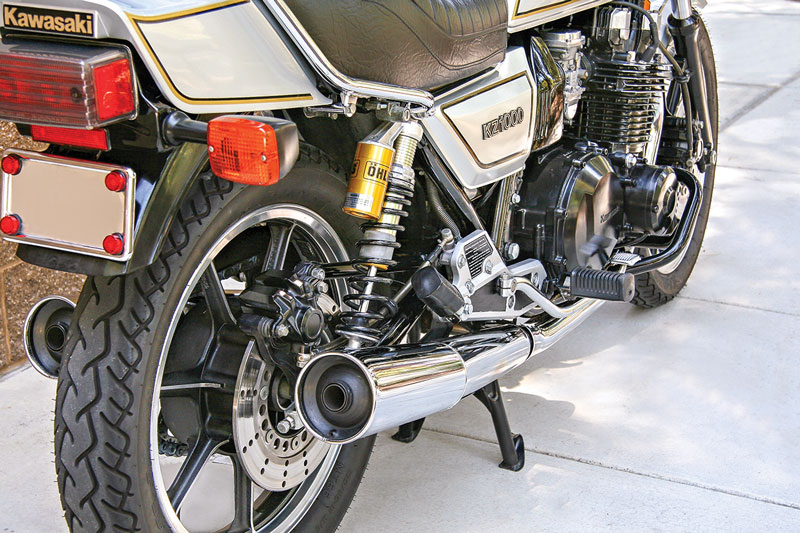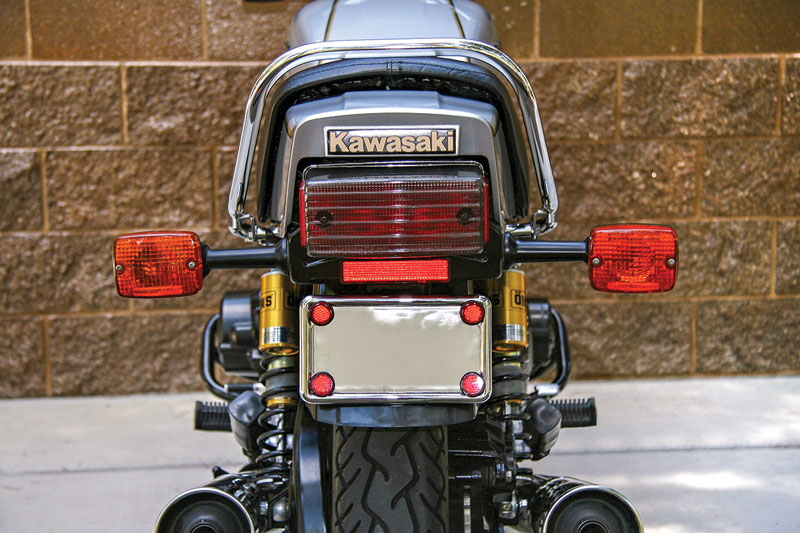
Numbers matter, even subtle numbers. Like the difference between 1,015cc and 998cc. Arriving at the smaller number meant decreasing the bore on Kawasaki’s 1980 KZ1000G from 70mm to 69.4mm on the 1981 KZ1000J. In addition to this minor adjustment to meet racing rules, just about everything else on the motorcycle had been changed as well, with the exception of the 66mm stroke.
Let’s go back a bit, to late 1972 when Kawasaki introduced the 903cc Z-1—the Killer Kaw, later labeled the KZ900 in 1976. It had a perfectly equal bore and stroke, 66 by 66mm, which was then bored out 4mm in 1977 to make the 1,015cc KZ1000A, maintaining the KZ’s reputation as the biggest, strongest UJM on the market. But the competition was getting fierce. Move up to 1981, and the new J model was an absolute delight—a street bike with Superbike potential. When the boys at Akashi, Kawasaki’s brain center, were given the task of revamping the 1,015cc KZ, the company’s bread-and-butter bike, they did it with gusto. It may have taken them a couple of years, but it was time well spent.

First, as always, more power. They lightened the crankshaft by hollowing out some bits, used a pork-chop flywheel rather than the previous full-circle design, and in the end shaved 4.9 pounds off the weight. Bigger valves went in the two-valve heads, and bigger, lighter, aluminum-bodied 34mm constant-velocity Mikuni carburetors were fitted. They fiddled with the camshaft timing so more gas could be stuffed into the combustion chambers and compressed 9.2 times. End result: almost 25 percent more horsepower, from 83 to 102 at 8,500 rpm. Mind you, those were Kawasaki numbers probably taken off the crankshaft, as the rear-wheel determination was more like 80 horses.
Ignition was by CDI, and anybody interested in the history of capacitor discharge ignition should go back to Nikola Tesla’s patent No.609250, filed in 1897. All agree that this modern electronic arrangement was far better than previous ignitions, especially with multi-cylinder engines. Exhaust used a four-into-two system, with a muffler on each side of the rear wheel.
Primary drive was by straight-cut gears, efficient albeit a bit noisy, and an extra plate was added to the clutch. Five gears moved the power along, from a 12.5 first-gear ratio to 4.9 fifth. No kickstarter was included, as riders now understood that the electric leg was very reliable. The output shaft was beefed up, and a new #630 chain with a breaking strength increased by more than 1,000 pounds went to the rear wheel. Chain technology development was going gangbusters at this point, as engines were generating more than 100 very stressful horsepower.

Second, the chassis. The diameter of the steel tubes in the frame was increased for better cornering rigidity, while the wall thickness was reduced. Stiffer frame with less weight; good thinking. The steering head, now using tapered roller bearings, was strengthened with two gussets and had a rake of 27.5 degrees, an increase of 1.5 degrees over the previous model. According to the spec sheets, wheelbase was 59.8 inches.
The front fork was enlarged to 38mm, and anti-stiction bushings were at top and bottom. It had 5.7 inches of travel and was air-adjustable, operating with a modest 7 psi for street use, 13 psi when getting enthusiastic. The pair of rear shock absorbers (the photo bike has a pair of aftermarket piggyback Öhlins) had a lot of adjustability, with seven positions for spring preload, five for rebound damping and almost four inches of travel. Seven-spoke aluminum alloy mag wheels used a 110/90-19 tire at the front, 120/80-18 at the rear. A pair of 9.3-inch discs up front were squeezed by single-piston calipers, as was the similar-sized disc at the back.
Third, rider comfort. This was not a racer, but a sportbike intended for the weekend rider—who might well want to put a few hundred miles on between Saturday morning and Sunday evening. To this end the front of the crankcase was rubber mounted to the full-cradle frame, eliminating much of the inevitable vibration. Handlebars were at a useful level, allowing for comfortable riding during this 55-mph era. (For all you young ’uns, back in 1974 the feds were worried about our consuming too much gasoline and imposed a national maximum speed limit of 55 mph, an excellent example of congressional incompetence.) Up front a speedometer, fuel gauge and tachometer were very readable, with the speedo going as high as 85 mph—when in fact 135 would have been more truthful.

A pleasantly large gas tank held 5.7 gallons, good for more than 200 miles, and the long, flat saddle was built to keep a rider happy for many hours. We don’t know what effort was put into shaving ounces off the body panels, but the J model ended up 30 pounds lighter than the previous G.
Choke if cold, turn the key, push the button and a very melodious sound emanated from the mufflers. An average rider would certainly enjoy his or her day in the saddle, while a more competent person would like the extremes to which the J could be pushed.
In 1981 Eddie Lawson won the AMA National Superbike Championship on an admittedly much modified KZ1000J, and Kawasaki decided to build a look-alike version, the ELR or Eddie Lawson Replica. This KZ1000R, advertised as a “street-legal superbike replica,” was offered to the masses for a few hundred dollars more than the $3,800 J version. The ELRs had a little nose-fairing, sophisticated Showa shocks and a black 4-into-1 Kerker exhaust.
Kawasaki also built 30 real-racer versions to sell to qualified racers, which were certainly not street-legal. These KZ1000R-S1 models cost a hefty $11,000.
Then the ZX bikes came along, and the only KZ1000 left was the police version—which could still pull over a speeding motorist with ease.









It’s funny that you see 903’s and 1015’s for sale but hardly ever see one of these 81-82’s.
This one must have sat in a warehouse or at a dealership until 1985 or so as it was not titled until then. Slow sales as I recall at that time plus there were other makes and models that were more “sporty”. It sure is a nice bike to ride though especially if it is the “newest” non-Harley bike you’ve ridden (like me)!!!
These must have been slow sellers, as this bike was not titled until 1985. More “sporty” bikes were coming out at that time and my guess is not many of these were sold. Sure is a nice rider though especially for someone like me whose only reference is Harleys and 1970s two strokes!
i had picked up one about 6 months ago. Didnt know t was a j-1. Rebuilt braking system (needed it bad from sitting
) . Test ride the damn bike, strange idle and speed. 1 st gear it idles right at 30 mph darn gears and bike had me scratching my head, too fast out the launch with no throttle, does not stall either. found this page so now i understand.
I have a kz1000 j2 in good condition everything original but need a mechanic to go through it any suggestions I’m in queens New York.
Look up Ralph Roneo in Norwich Ct. Hes the best and very fair. Wait until you see his Z1 900 and 1000J bikes
Ciro, you still have this bike?
Anyone looking for a.kz1000 J engine?
I have a bunch of parts for a 1982 kz1000 LTD.
EVERYTHING GOES TOGETHER.
Engine has around 12,200 miles
I have a tank, seat , front and rear brakes, front and back fenders, speedo , tack, chain guard, blinkers. And more.
Have carbs for engine.
$ 1500.00 for all
Just picked up a 1981 K1000j bobtail roller. Needing an engine..lol
Have the whole bike for sale..81 kz1000j would like to hear an offer
Mike, You still have this J for sale? Long shot I know….
Any chance you have the triple trees off of the bike? Looking for a set
looking for 1000 j parts
I have a 1982 KZ1000-J for sale. Runs great & looks great too.
Steph, I would be interested in your KZ1000J for sale.
How can we connect?
Maybe you can message me on my Facebook page HubCityMusic
Please contact about the J – thanks
Stevemuckqueen@hotmail.com
I used to have a 1981 KZ1000J bike. It had one of the most comfortable seats for me, of all the bikes I’ve owned. Unfortunately, it had a tendency to pogo in the curves due to frame flex. Excellent everyday commuter bike however, for the time. The police specials were still being produced for many years after 1981-82. Because it was a good solid bike.
Looking at one for sale in semi original but rideable condition in NZ for $NZ7000 or $4400US – bit rich right?
Well, I’m picking one up tommorow that needs some carb work done on it and maybe a little more TLC for $350.00 US Dollars. Millage is around 30k. Plan is to convert to either Scrambler or maybe a Cafe Racer after I go through the engine.
you wanting to sell the bike ?ichal James , Baton Rouge la.
I have an ‘81 with 13k for sale now. It has been sitting for close to 10 years but ran great when parked. If interested let me know.
I would be interested in 13k mile 1000J ryanreed427bb@gmail.com ive been looking for a couple of years want to make EDDIE Replica 1000R have ZRX11 Replica 77 LTD 79 Drag
I own the bike featured here and would be selling to sell it. Cosmetically, its an 8 or so and runs excellent. My e-mail is lewmartincic@aol.com.
I’m kicking myself for not seeing the comment about my 82 KZ1000J. I ended up riding it more and love it! I get stopped often by admirers of this bike. That never happens on my cruiser. Regrettably I think I need to part with it. I’m leaving to travel long term in a cool motorhome I renovated & decided a single woman & her dog doe not need 3 vehicles, 2 motorcycles & a wobble box! (That’s the motorhome) you can find me on Facebook at Stephanie Folkman in Park City Utah. Hit me up if interested.
Hello, i can’t find your FB. Maybe you can contact me stevemuckqueen@hotmail.com
Thanks
I have a all original 81 1000 j with 13k runs rides perfect original paint think original tires too I would sell mine fair 903 268 9574
Anyone selling a clean original J1 or J2 model pref in NE USA please let me know. Thanks. Stevemuckqueen@hotmail.com
I would like to know what my husband’s Kawasaki KZ100 A is worth.
The original owner had the option of putting on mag wheels and a saddle seat. Then he added a Vette box on the back. Do you have any suggestions? Please reply at loismedecke@gmail.com if possible. My husband cannot ride the bike any more.
Thanks
I hope you have time to reply.
I forgot to say that it is a 1978 motorcycle.
My favorite bike, I bought a brand new ’82 KZ1000-J for $1999 in metallic silver and chrome, I had the carbs rejected & installed a header and it was one slick street machine
I have a factory manual for a 1982 1000j ! 30 bucks in Modesto